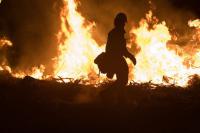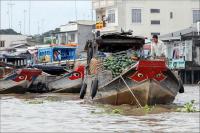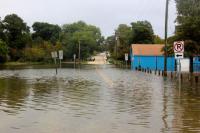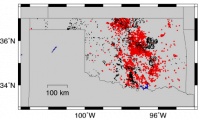-
Human activity a major factor driving wildfires

A new study that examines California wildfires found that human activity — such as tossing a lit cigarette along a highway — explains as much about the fires’ frequency and locations as climate influences. The researchers systematically looked at human behaviors and climate change together, a type of review that rarely is attempted on an area of land the size of California.
-
-
Repairing earthquake-damaged bridge columns in days, not weeks
In just thirty seconds, a devastating earthquake like the ones that struck Japan and Ecuador can render a city helpless. With roadways split and bridges severely damaged, residents and emergency personnel could be prevented from moving around to rebuild. Normally, it takes weeks to repair the cracking or spalling of columns on just one bridge damaged in an earthquake. Researchers have developed a new process of fixing columns that takes as little as a few days.
-
-
Putting consistent value on experts' uncertainty on climate change models
Science can flourish when experts disagree, but in the governmental realm uncertainty can lead to inadequate policy and preparedness. When it comes to climate change, it can be OK for computational models to differ on what future sea levels will be. The same flexibility does not exist for determining the height of a seawall needed to protect people from devastating floods. For the first time in the climate field, researchers have combined two techniques long used in fields where uncertainty is coupled with a crucial need for accurate risk-assessment — such as nuclear energy — in order to bridge the gap between projections of Earth’s future climate and the need to prepare for it.
-
-
Rising seas put Vietnam in the “bull’s eye” of rising seas

A rising sea level — for a country like Vietnam, with 2,000 miles of coastline — presents a major environmental and food security challenge, especially in the Mekong River Delta region where 22 percent of the population lives and about half of the country’s food is produced.
-
-
“G-Science” academies call for strengthening global disaster resilience

In the decade between 2005 and 2014, more than 6,000 natural and technological disasters occurred around the world, killing more than 0.8 million people, displacing millions more, and costing more than $1 trillion. Losses due to disasters are increasing in both developed and developing countries. Human factors that increase exposure and vulnerability, such as poverty, rapid population growth, disorderly urbanization, corruption, conflict and changes in land use, poor infrastructure including non-engineered housing, together with effects of climate change on weather patterns with increased extreme events, aggravate the negative consequences of natural and technological hazards.
-
-
New Web portal for coastal resilience

William & Mary Law School and William & Mary’s Virginia Institute of Marine Science (VIMS) are collaborating on a new Web site which will provide key information to support local, regional, and state efforts to adapt to sea-level rise. Tidal and storm surge flooding risks, FEMA flood zone maps, storm history, and critical infrastructure risk assessments are all topics that are likely to be included on the Web site. Information about conditions of shorelines, wetlands, beaches, and coastal forests will also be in the portal.
-
-
Changing climate in Michigan poses an emerging public health threat

Changing climate conditions — including warmer temperatures and an increased frequency of heavy rainstorms — represent “an emerging threat to public health in Michigan,” according to a new report from University of Michigan researchers and state health officials.
-
-
1.5°C vs 2°C global warming: Half a degree makes a big difference

European researchers have found substantially different climate change impacts for a global warming of 1.5°C and 2°C by 2100, the two temperature limits included in the Paris climate agreement. The additional 0.5°C would mean a 10-cm-higher global sea-level rise by 2100, longer heat waves, and would result in virtually all tropical coral reefs being at risk.
-
-
Citizen seismologists enhance the impacts of earthquake studies
From matchbook-sized sensors plugged into a desktop computer to location-tagged tweets, the earthquake data provided by “citizen seismologists” have grown in size and quality since 2000, according to the field’s researchers.
-
-
Globe continues to break heat records -- for 11th straight month
At the risk of sounding like a broken record, March set another heat record for the globe. As Earth continues to warm, and is influenced by phenomena such as El Niño, global temperature records are piling up. For 2016 year to date (January-March), the average temperature for the globe was 2.07 degrees F above the twentieth-century average. This was the highest temperature for this period in the 1880–2016 record.
-
-
How could we build an invisibility cloak to hide Earth from an alien civilization?
What would it take to hide an entire planet? It sounds more like a question posed in an episode of “Star Trek” than in academic discourse, but sometimes the bleeding edge of science blurs with themes found in science fiction. Of course we’ve been leaking our own position to distant stars via radio and television signals for six decades now, largely ignorant of the cosmic implications. But several notable scientists, such as Stephen Hawking, have publicly voiced concerns about revealing our presence to other civilizations. These concerns largely draw from the darker chapters of our own history, when a more advanced civilization would subjugate and displace a less advanced one.
-
-
Digital mapping project tracks the last moments of the victims of Japan’s 2011 tsunami
Digital archives track the evacuation patterns of 2011 Great East Japan Earthquake victims between the time the earthquake and tsunami struck. The Tokyo Metropolitan University researchers who created the digital archives say they will make use of the archive to analyze evacuation behaviors — encouraging people, for instance, to avoid overestimating evacuation sites and head to higher ground.
-
-
Texas earthquake may have been manmade, but more data needed to assess hazards

The most comprehensive analysis to date of a series of earthquakes that included a 4.8 magnitude event in East Texas in 2012 has found it plausible that the earthquakes were caused by wastewater injection. The findings also underscore the difficulty of conclusively tying specific earthquakes to human activity using currently available subsurface data.
-
-
Three years on, the Chelyabinsk superbolide mystery continues
On 15 February 2013, the approach of asteroid (367943) Duende to our planet was being closely monitored by both the public and the scientific community worldwide when suddenly a superbolide entered the atmosphere above the region of Chelyabinsk in Russia. Three years and hundreds of published scientific studies later, we are still looking for the origin of such unexpected visitor, which caused damage to hundreds of buildings and injuries to nearly 1,500 people.
-
-
Underestimate global warming by exaggerating cloud “brightening”
As the atmosphere warms, clouds become increasingly composed of liquid rather than ice, making them brighter. Because liquid clouds reflect more sunlight back to space than ice clouds, this “cloud phase feedback” acts as a brake on global warming in climate models. Researchers at Lawrence Livermore National Laboratory and Yale University have found, however, that climate models are aggressively making clouds “brighter” as the planet warms. This may be causing models to underestimate how much global warming will occur due to increasing carbon dioxide.
-
More headlines
The long view
Strengthening School Violence Prevention
Violence by K-12 students is disturbingly common. Ensuring that schools have effective ways to identify and prevent such incidents is becoming increasingly important. Expanding intervention options and supporting K-12 school efforts in Behavioral Threat Assessment and Management (BTAM) would help.
Huge Areas May Face Possibly Fatal Heat Waves if Warming Continues
A new assessment warns that if Earth’s average temperature reaches 2 degrees C over the preindustrial average, widespread areas may become too hot during extreme heat events for many people to survive without artificial cooling.
Trump’s Cuts to Federal Wildfire Crews Could Have “Scary” Consequences
President Donald Trump’s moves to slash the federal workforce have gutted the ranks of wildland firefighters and support personnel, fire professionals warn, leaving communities to face deadly consequences when big blazes arrive this summer. States, tribes and fire chiefs are preparing for a fire season with minimal federal support.
